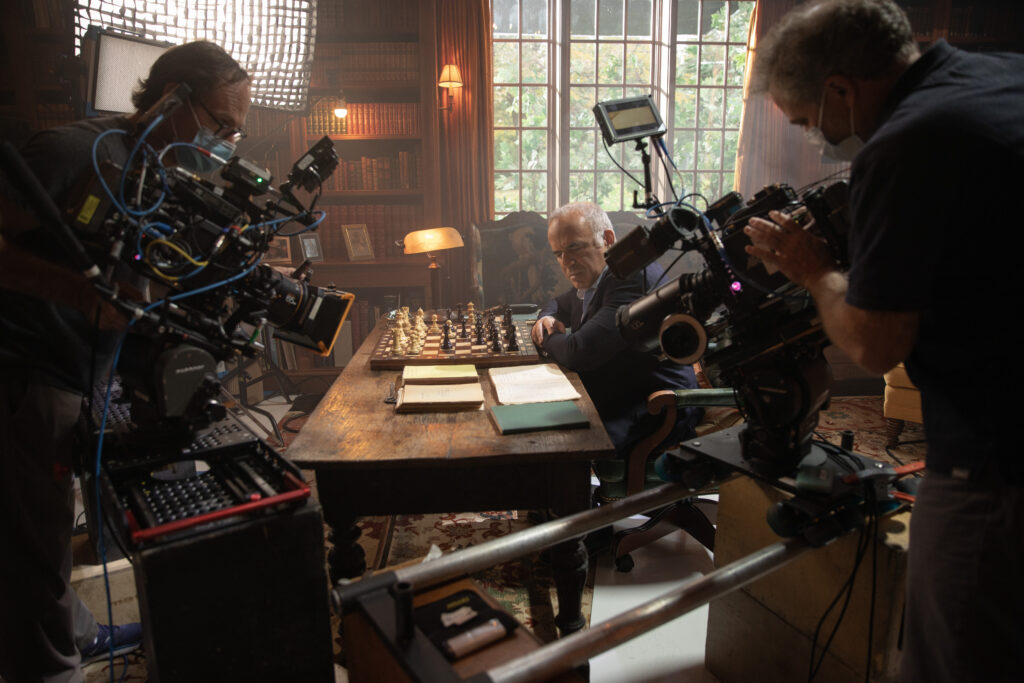How do you create your Video Marketing Strategy?

Are you looking to launch a brand, product, or service with video marketing? You’ve come to the right place!
Video marketing is one of the most effective ways to connect with your audience and promote your brand. Whether you’re a small business just starting out, or a large corporation looking to expand your reach, video can help you achieve your goals.
But you can’t just… start shooting. It’s important to create a holistic plan that fits with your brand, goals, and budget. It’s a complex subject with no single correct approach, but this article will give you the basics.
Here’s what we’ll cover:
- Identifying your audience
- Developing your message
- Choosing your video channels
- Planning and creating your content
- Distributing and promoting your videos
- Learning from and adapting your strategy
There’s a lot to go over, so do a quick stretch and pour yourself a fresh cup of coffee. By the end of the guide, you’ll be ready to start creating videos that will connect with your audience and grow your business.
And when you’re ready to take the next steps, Indigo Productions is here to help. We’re a full-service video production company that can handle virtually any kind of video content, bringing your video marketing strategy to life. You can learn more about our services here and our process.
How do you identify your audience?

The most important people in any video production? The audience.
Video marketing is ultimately storytelling, and telling a good story means capturing the audience’s attention and taking them on a journey with a clearly understood message.
Start by identifying your audience. Your target audience is the group of people that you want to reach with your videos. It’s essential to understand who they are, what they’re interested in, and their pain points so that you can create content that will resonate with them.
So, how do you identify your target audience? If you have existing customers or contacts, you likely already know quite a bit about them. You might have a specific target clientele you’d like to acquire, or a new market or industry where you’d like to expand.
If you are unsure about your audience, you can conduct audience research. This includes surveys, focus groups, and data from your website and social media channels. Audience research supplies valuable information about your audience’s demographics, interests, and behavior.
Another option is to create buyer personas – fictional representations of your ideal customer based on the research you’ve collected. It includes information such as their age, gender, occupation, income, and interests. Creating buyer personas will help you understand your target audience on a deeper level and tailor your video content to their specific needs and pain points.
Once you’ve identified your target audience, you can use that information to create unique video content that will resonate with them and achieve your marketing goals.
It’s important to review your audience research and buyer personas regularly, as the demographics and behavior of your target audience may change over time.
How do you develop your message?
Now that you’ve identified your target audience and understand their needs, it’s time to develop your message. Your message is the core idea or theme that you want to communicate through your video content. It’s the thing that you want your audience to remember and take away from your videos.
When developing your message, it’s essential to keep your audience’s problems in mind. What keeps them up at night? What’s the issue they’re trying to solve? While it’s compelling to talk about your brand and your goals, the more effective strategy is to keep the focus on the goals of your audience.
That said, your message should align with your brand’s mission and values. For example, if your brand’s mission is to promote sustainability, your message could be about the importance of protecting the environment. If you pride yourself on your technology, highlight it as a dominant feature.
It’s also important to keep in mind the specific goals you want to achieve with your video content. Are you trying to increase brand awareness, generate leads, or drive sales? Your message should be tailored to achieve the correct goals.
Once you have your message, you can then use it to guide the creation of your video content. Your message should be present in all of your videos, whether they’re product demos, how-to videos, or brand videos.
And don’t forget to choose a specific tone. Kind or bold? Confident or humble? The tone should align with your brand and be appropriate for your target audience. For example, a serious tone might be more appropriate for an educational video about a sensitive topic. While a more casual and friendly tone might work better for a brand video showcasing your company culture.
In addition to your message, it’s important to have a consistent visual style throughout your videos. This will make it easy for your audience to recognize your videos and develop a sense of trust and familiarity with your brand.
How do you choose your video channels?

Are you making a Super Bowl spot, or TikTok ads?
Your channel mix is the combination of places you’ll be showing your video. Before you start creating content, you’ll want to know where it’s going to run. It’s not just about creating awesome videos, it’s also about getting that content in front of the right people. With so many channels out there, it can be tough to know where to focus your efforts.
Here’s a guide on how to select the right channel mix for your video marketing content.
First things first, let’s go back to your audience. Who are they and where do they hang out online? Are they on Instagram or TikTok? Are they on YouTube or Vimeo? Knowing where your audience is will help you determine which channels to focus on.
Next, revisit your goals. Are you looking to drive sales or increase brand awareness? Different channels will be better suited for different goals. For example, if you’re looking to drive sales, focus on channels where you can add a link to your product page in the video description. If you’re looking to increase brand awareness, focus on channels where you can tell a compelling brand story.
Some channels are better suited for short, snackable content, while others are better for longer, more in-depth content. For example, TikTok is great for short, funny videos, while YouTube is great for long-form content like tutorials and vlogs.
And don’t forget your budget. A TV-quality spot can be expensive, but you can usually make more casual social content for less.
Make sure you don’t spread yourself too thin. It’s better to focus on a few channels and do them well than to try to be on every channel and do a mediocre job. Pick the channels that are the best fit for your audience, goals, and content, and go all in on them.
How much does video marketing cost?
So, you have a good idea of your audience, message, and distribution channels. But what it will cost to execute your video marketing strategy and plan?
We hate it say it, but…” it depends.”
The truth is, the cost of video marketing is highly variable. It all depends on your concept, the scale of your production, and your media plan. Thankfully, these factors are within your control. You can make brilliant and effective lower-cost ads, or pull out all the stops to bring your vision to life.
Consider these core principles when determining what budget is right for your video marketing goals:
Your production values should meet or exceed audience expectations
With the amount of time modern audiences spend watching video, they can easily spot bad acting, shaky camerawork, and poor lighting. Give them something that will present your brand or product in the best possible light
Try to calculate your desired return on ad spend (ROAS), and set your budget accordingly
Are you looking to build awareness or drive sales? How much is this growth worth to you? Every platform and product is different. A 400% return is considered fair—this means if you spend $1 on ads, you make $4 in revenue
Plan where your video will run in advance, and create the right content for your audience
You don’t need a Michael Bay budget to make an effective TikTok ad. But you still need to invest in the right creative, talent, and script. Only doing social? Shoot for social. Going for connected TV? You’ll need to shoot for a higher standard.

If you’ve never shot a video before, it can be a bit difficult to imagine all the budget line items.
To help, we’ve put together an explanation of some of the most common video production expenses, examples of videos in different price ranges, and an overview of distribution costs.
Keep in mind, a single commercial will be far less pricey than a complete marketing campaign. If you are planning a series of videos, your cost will be a multiple of what we have outlined below.
Common Video Production Expenses

Creative Services:
A great strategy is wasted on a bad execution.
That’s why video production companies and creative agencies can charge anywhere from a few thousand dollars to hundreds of thousands for a great video idea. The higher end of that scale includes storyboarding, scripting, look development, and market research. It’s often worth it to trust the pros!
If you are confident in your in-house creative team or already have a strong idea, this is a place where you can save money. But if you are struggling with the creative side of things, don’t hesitate to get some help. Many production companies have in-house teams, and advertising and creative agencies are also popular.
Director:
The director is the central figure who sees your project through from concept to reality. A director can make or break your production, and typically won’t work for free.
It’s essential to partner with a director who will collaborate with you throughout the entire filmmaking process, finding smart solutions to your shoot’s challenges and ensuring your vision survives the input of your many stakeholders.
Some directors have a day rate of only a thousand dollars, while others with resumes of feature films, television, or high-end ads are exponentially more expensive. And if you want a famous director to helm your shoot, be prepared to spend big.
Don’t forget: there are great directors at all price points. What’s most important is choosing the best director for your particular project.

Talent:
You’ll have to pay your actors for their time, talents, and the right to use their appearance in your marketing. But finding the right talent is tough, and the casting process is also a considerable expense.
Depending on the requirements of your script and audience demographics, it may take many auditions to find the perfect actor. By enlisting a casting director or a casting agency, you can streamline your search for candidates but at a premium price.
Brands frequently want a celebrity to be the face of their marketing campaign, and who can blame them? Celebrity talent does wonders for advertising. Just be prepared for sticker shock. Fees can run into the millions for top-tier talent, but sometimes you can get creative with revenue shares, equity, or even free product.
Crew:
A skilled crew keeps your shoot on schedule while executing shots with extreme virtuosity. If you’ve never seen a film set, you might be surprised at how many people it takes! It’s easy for crew salaries to eat up the majority of your budget, but for good reason.
There are two types of crews: union and non-union. While there is plenty of talent in non-union crews, many of the industry’s top names belong to a union. Unions are very clear about rates, breaks, and other shoot regulations. Once a union team is hired, the shoot must conform to their guidelines or risk severe financial penalties. For a better sense of what unions exist and what you’ll have to pay to employ their members, click here.
It is generally cheaper to hire a non-union crew, and there is much more room for negotiation, but day rates can still be over a thousand dollars.

Equipment:
You want your video to look as good as possible, but buying professional-grade lights, cameras, and lenses costs well over a hundred thousand dollars. Thankfully, all this equipment can be rented.
When renting, items that cost thousands can be obtained for a few hundred per day. Consult with industry professionals and carefully consider exactly what you need for the shoot so that you don’t overspend but also aren’t left without a vital piece of equipment. And don’t forget insurance. If you break it, you buy it!
Props and costumes:
Perhaps your concept calls for Victorian aristocrats lounging in a solarium, or cowboys who time-travel to a cyberpunk megacity. To sell your setting and properly tell your story, you’ll need custom props and costumes. Don’t cheap out here, poor production value distracts your audience and harms the effectiveness of your message!
If your budget is limited, ingenuity and out-of-the-box thinking can make a little go a long way. Carefully choose your angles, and only spend on what will be seen in frame. You can always keep it simple.

Locations:
Locations can be free or your shoot’s biggest expense. Ultimately, it comes down to your needs and ability to negotiate. Renting out a small studio, for instance, will be much cheaper than shutting down a street in New York. And the more locations you need, the pricier.
Here’s a pro tip: see if you can fake one real-life location as multiple locations from your script. Professional productions do this frequently to save time and money, and the viewer is none the wiser.
Locations should be woven into the fabric of your story, so research the costs of various shooting locations at the development stage. For niche locations with unique requirements, consider consulting a location scout. And if your location is “out of this world” or otherwise inaccessible, you can hire visual effects artists to digitally create or extend your set.
But don’t forget. Some of the best ads in the world were shot in a normal living room, on the street, or in a car.

Editing and Post-Production:
It all comes together in the edit. This is where all your takes, performances, and angles are stitched together into a near-final product. We’re sorry to say that even the best footage can be ruined by an incompetent editor. But great editors can transform poor footage into something truly special, or further elevate an already successful shoot.
Editors typically charge by the hour, although some charge by the day or by the project. As a general rule of thumb, the more expensive the editor the more skilled and efficient their work. So while you may pay more for each minute of their work, there will be fewer total minutes. Common rates for experienced editors are $100 – $200 dollars an hour or $500 – $1,000 dollars per day.
Other post-production expenses include motion graphics, color correction, and the purchase of music or stock footage, which can cost hundreds to thousands per track or clip for broadcast rights.
Examples of Videos at Various Budgets
Need more concrete examples of what you can get for your money? Here are three successful videos Indigo Productions has created at different price ranges.
Budget of 10-20k
At this budget, you’re likely looking at graphics and editing of found footage and existing assets. But with some smart planning, you may be able to get away with a simple, interview-style shoot or a 2D animated video. We did just that with this Covid-19 Vaccination PSA:
Budget of 50-60k
This is a healthy budget for a small-scale narrative or docu-style spot. You won’t be able to pull out all the stops but can create compelling work that impresses, like this commercial we made for the sports betting app Sleeper:
Budget of 100k+
Now you can really start to splurge! Unique locations, a large cast, and feature-film-level cinematography. Our client needed to make a statement for the launch of their NFT platform and had the budget to do so:
For an even more in-depth breakdown and other budgets with video examples, see our blog dedicated to the subject.
Video Distribution Costs
We know that costs can be decisive factors in your distribution channel decisions. Let’s take a look at a few key distribution channels and the budget they require for an average ad buy.

Self-Distribution
If your brand has a Youtube channel with millions of subscribers, a popular website, or a network of affiliates who can post and boost your video, then you are in luck. Distribution is just about free. But it would be smart to consider additional channels to expand your audience beyond those already tuned in.
Social Media
Social media ad buys can be incredibly cost-effective. Youtube ads go for as low as ten cents per view. And the average monthly spend for social media advertising is between $4,000 and $8,000. This spend can be across platforms or focused on the most relevant one. Compare the advertising costs per social media site against the benefit of reaching that user base.

Linear and Connected TV
Linear TV refers to traditional TV broadcasts, where you flip through channels and watch the commercials. For a national business, linear TV can be much more cost-effective than digital or connected TV ads on services like Hulu.
But linear TV is hard to track and measure, while connected TVs offer better data on who saw your ad, who skipped it, and which households made a purchase!
Prices depend on the network, time of day, ad break, number of households, and popularity of the program. Ads during big-ticket events, such as the Superbowl, can be over a million dollars for one spot, while advertising during the local news is a tiny fraction of that.
TV ads are typically priced at a Cost per Mille, or CPM. This is the dollar amount for every 1,000 views. A typical range is $10 – $70 CPM.
Because placing ads can be tricky, brands often choose to partner with marketing firms that specialize in getting their clients the best slots to achieve their marketing goals and the most bang for their buck. They can also prevent potentially harmful saturation of your ad, such as it playing multiple times in a row to the same viewer.
There’s a final cost to consider when it comes to television and streaming. You’ll need to secure a broadcast license for your assets, including stock footage and music. While a standard commercial license is relatively inexpensive and will cover social media campaigns, a broadcast license can be thousands of dollars. And these licenses expire, so you can’t plan on running the same ad forever without paying up.
How do you plan and create content?
You have all the pieces in place. Now it’s time to start making content! Content creation can be costly, but quality is worth the investment. When promoting your business, you want to make the best possible impression.
In spite of all the power and flexibility of modern video-making tools, the best projects are the ones that are the best planned. There are a few important things you’ll need to consider.
Scripting your video may seem like a small step in the production process, but it’s actually one of the most important. A well-written script can make all the difference in how your video is received by your audience and can help you achieve your goals.
First, it helps you stay on track. You know exactly what you want to say and can make sure you include all the important information. This is especially helpful if you’re creating a video with a specific goal in mind, such as driving sales or increasing brand awareness.
Scripting also helps you structure your video in a way that makes sense and keeps your audience engaged. It helps you create a logical flow and progression of ideas that will keep your viewers interested and on the edge of their seats.
It also assists with planning your shots and filming locations. When you have a script, you know exactly what you need to film and where. This saves you time and money on production. You can even find clever ways to get multiple edits and versions from a single shoot.
But for casting, camerawork, sound, and editing—it’s usually best to hire a professional.
Hiring a professional video production company can be a smart move. While it may seem like an added expense, the benefits of working with a production company can far outweigh the costs. Here’s why:
First, professional video production companies have the experience and expertise to create high-quality videos that are tailored to your specific needs. They have the latest equipment, know how to use it, and have the skills to edit and produce a professional video.
Working with a production company also saves you time and energy. They handle all aspects of the production process, from pre-production planning to post-production editing, so you can focus on running your business.
If you need the help, a production company can assist with scripting and concept development. They’ll guide you as you create a compelling story that grabs the attention of your audience and achieves your business goals.
Additionally, production companies often have a network of industry professionals that they can call upon to bring your video to life. This includes actors, voiceover artists, and music composers, which adds extra value to your video.
A production company can also handle the distribution and promotion of your video, making recommendations on video formatting. By working with a production company, you can ensure that your video is of the highest quality and reaches the right audience.
Our 6 Favorite Types of Videos
Need inspiration for the first project in your video marketing strategy? We love creating these six types of videos, which have a proven record of success.
Commercials:
When we think of advertising, most of us think of commercials. This is your chance to wow your audience and define your brand. Some commercials cost more than feature films. Costs include celebrity talent, extravagant sets, 3D animation, and top writers and creative talent. But some of the world’s most memorable commercials were shot on tiny budgets.
Commercials can be anywhere from 15 to 60 seconds, and there are usually multiple versions of your commercial for different formats and media placements. You can air the commercial on television as a 30-second spot, create a shorter version for social media, or even a “director’s cut” for your website and YouTube channels.
The best ad campaigns have a consistent look, feel, voice, and central theme. That’s why your commercial should be carefully integrated with all other elements of your marketing campaign, including outdoor, audio, or anything else in your strategy. Take a holistic approach to your branding to amplify your message and avoid consumer confusion. You can get extra mileage from your commercial by including it in other places in your campaign.
Indigo Productions recently led an ad campaign for PetMeds, a major online pet retailer. Our approach was to develop a central concept, and find creative ways to share it across all their channels. We started by developing, shooting, and editing their first-ever national commercials, and then used the concept to create audio ads for platforms like Spotify. Our concept? The diary of pets. Check out how it turned out:
Social Media Videos:
Several years ago, the popularity of social media overtook traditional media and TV. People spend countless hours scrolling, liking, and posting. Social media videos cannot be ignored!
While simply uploading your commercial to social media might get results, it won’t maximize your success. That’s because social media videos do best when they are designed for the platform and are tailored to its audience and unique culture.
So, what should you keep in mind when developing marketing videos for social media?
- Duration: Social media videos should be short and sweet, 30 seconds or less!
- Aspect Ratio: TV’s are still horizontal, but vertical videos are winning the war. Make sure whatever you shoot is viewable on a phone held in portrait mode.
- Attention-grabbing opening: Scroll. Scroll. Scroll. Social media users are ruthless. They only give you a second or two before swiping to the next item on their feed, so be sure your opening makes a splash.
- Call To Action: One of the biggest advantages of social videos is that they are highly interactive. You can get the viewer to click, sign up, or even make a purchase on the spot. So give viewers a reason to click and a webpage to visit with a concise and enticing call to action.
- Captions: When people browse their phones, they might not have sound enabled. Adding text and captions to your video makes sure the message gets across with or without sound.
Indigo Productions has extensive experience creating videos for social media. Some of our favorite videos have been our figure launches for Madame Tussauds, which have garnered millions of views.
Sales Videos:
Your commercial or social media video caught their attention, a sales video can help close the deal.
A sales video is designed from the ground up to convert viewers into paying customers. These are designed for viewers who are closer to making a purchase—further down the “sales funnel.” Take the top features of your product and develop a video about how your product can solve problems or address needs.
For example, if your product is a CRM platform, you’ll want to outline its ease of use, as well as how it has simplified the work lives of its users, saving them money. On the other hand, if you are selling a luxury item like a high-end watch, you’ll want to highlight its materials, design, and reliability.
Sales videos can be longer than commercials and social media videos because your viewer is likely already interested in your product and wants to learn more. Our video for McGraw Hill’s Studio Space program uses flashy graphics to show the software’s features in action:
Event Videos:
Event videos capture activations for use in your digital marketing campaign, maximizing the value of your events.
Audiences enjoy watching organic and authentic interactions between a company and its customers. Just make sure your event is planned with video content in mind. Shooting and recording audio at a live event can be challenging, and it can be difficult to prioritize what footage to get. Set an agenda for your video team ahead of time, and develop some visually interesting activities for them to film. After the event, the edit team will work their magic so viewers at home can feel like they were there.
Corporate presentations can also be transformed into effective video content. Think of Apple’s live-streamed product announcement videos and other similar promotions. What was presented in front of a small audience can become effective video seen by hundreds of millions.
Indigo Productions has been hired to create videos at events for some of the world’s best-known organizations. One of our favorite events was the Habitat for Humanity Women Build Event:
Explainer Videos:
Do you have a great product that’s just a bit difficult to understand? Then your marketing strategy will greatly benefit from an explainer video.
Explainer videos are brief, narrated overviews of your product and how it works. They strike a friendly, lighthearted tone that makes learning about your product fun and accessible. And they often employ 2D animation for clear and compelling visuals.
A great script and a comprehensive storyboard will help ensure your explainer video leaves the audience confident they understand why they should use your product. Try showing the video to those who have never heard of your company, and ask them some questions about your product’s features. That will help you gauge your video’s success.
Take a look at this explainer video we created to provide an overview of a new United Healthcare initiative:
Sizzle Reels:
Have a lot of ground to cover or want to highlight the launch of a new line of products? A sizzle reel builds excitement around a dazzling array of activities.
Sizzle reels are a series of short clips of your highest-quality footage and sound bites. They often incorporate motion graphics, on-screen text, satisfying sound effects, or voice-over to engage the viewer. And they fit right in on social media. Sizzle reels can also piece together your marketing materials into one cohesive package.
Remember, a sizzle reel is still telling a story about your brand and your products. Make sure there is a logical flow and order to your clips. Think of a sizzle reel as an appetizer to the main course that is the rest of your marketing materials.
Sizzle reels are also frequently used to summarize the best moments from a meeting or consumer conference. Check out this meeting sizzle we created for Krux, later acquired by Salesforce:
Choosing Your Video’s Creative Approach and Tone
Great! You’ve chosen a video type and figured out your goals. But just knowing you are creating a commercial, sales video, or sizzle reel isn’t enough. Now you have to make decisions about the creative approach of your video.
There may be some conflicting ideas on your team. Funny or serious? Live action or animation? Interviews with customers, or actors? Choosing the creative approach of your video will enable you to finalize your concept and select the right video production partner.
The genre and tone of your video should be consistent with the rest of your marketing campaign and brand voice. And most importantly it should be true to your company. If your brand is friendly, embrace it! If your brand is edgy, dial up the tension. And if your customers are your best advocates, think about including them in your video marketing strategy.
Let’s look at some of the top approaches you can choose for your video, and what goals they best serve.
Mini-documentary:
If you need to build trust between your audience and your brand, or emphasize the human element of your company, a documentary is the perfect approach.
You can capture employees and executives working day-to-day, set up a series of interviews with the founders of your company, or go behind the scenes with your R&D and manufacturing departments. Let the cameras roll, and shape your story in the edit using the most evocative moments.
But don’t just leave your video’s success to chance. Create an outline, including expected talking points, investigate which employees have the best anecdotes, and make sure your staff is comfortable on camera and has time to prepare for the shoot.
Testimonial:
Testimonials feature your customers discussing why they love your product. These testimonials can be scripted and curated, or off-the-cuff documentary-style recordings. For testimonials, it’s key to find people who have authentic, positive experiences with your brand or unique stories about how your product improved their lives. The customers you highlight should appeal to the demographics you are targeting.
Consider the setting of your testimonial video. Filming in your customers’ homes will suggest a different tone than filming them at your corporate offices, which will feel different than on-the-street interviews.
It can be hard for a non-actor or person without media training to be comfortable on camera, so plan some activities to get them comfortable, and get them talking. Warm them up with topics you know they love talking about. Have them react to a new product to give your testimonial an additional dynamic that stands out. Capturing their pure excitement can be contagious.
Comedy:
Comedic videos are extremely popular, and making something funny is the first instinct of many brands. People feel good when they laugh, funny spots are memorable, and you want people to feel good about your product. That’s why comedy videos are such impactful marketing tools.
Humor also highlights inconveniences your audience may have accepted as part of life, never realizing there might be a better way—your product or service.
Often comedy ads don’t put much emphasis on the product and what it does. Rather, they seek to create a memorable experience with strong branding, so that viewers associate these positive feelings with the company.
A word of warning: comedy is not easy. What’s funny in the conference room may not land with a broader audience. Even the world’s best agencies and biggest brands fail at comedy—just watch any Super Bowl.
Drama:
If you’re solving a serious or weighty problem, be more serious. A dramatic spot can be warm, friendly, caring, or even create a bold sense of urgency. You can tell a real story about your mission, focusing on the problem your company hopes to solve.
In dramatic videos, execution matters. Be true to the reality of the situation, and avoid sub-par actors and production values. Dedicate enough time during pre-production to make sure your story really works and hire the cast and crew that will best bring it to life. The last thing you want to create is unintentional comedy!
Dramatic ads don’t always have to illustrate a problem and solution. They can also be brand videos to create a specific reputation or feeling around your company.
Animation:
Animation is a great option if you want to tell a story without live actors, sets, or more complicated effects. Animation is a creative approach that can be used to tell dramatic, comedic, or any other kind of stories you like.
Animation can typically be created “in the box,” meaning entirely on a computer without ever having to leave the office, deal with weather delays, or find a place to park the production truck. It can often be less costly than live action.
This approach is not just for children. You can use it to create sophisticated product demos or 3d effects. Use it to show off the construction process of a new building, or animate statistics that would otherwise be more difficult to digest. Animation is also great at visualizing abstract concepts, providing extreme close-ups of a product, portraying out-of-this-world imagery, and conveying a colorful, fun mood.
Most brands have at least dabbled in animation as part of their marketing strategy. Don’t forget that light animation mixes well with other choices.
Establishing the Tone
Each of these approaches can vary in tone. A documentary can be tense or whimsical, comedy quirky or dark, and drama melancholic or warm. It’s important to have a strong sense of tone from the get-go, and for your tone to be aligned with your overall strategy and brand voice. Moving into production without a clear sense of tone is a recipe for a muddled final result that can’t be molded into what you had in mind.
Consider unexpected pairings for unique videos aimed at starting a conversation or capturing your brand’s distinctive qualities. Or play it straight and give the viewer something more familiar and easy to understand.
Remember: the tone and creative approach of your concept can have just as much of an impact as the concept itself. We’ve all seen ordinary concepts elevated by ingenious execution, and amazing ideas let down by strange creative choices. Audiences are exposed to thousands of ads a day. They might not remember the specifics of each one, but they will remember how it made them feel. So it is absolutely vital to strike the right tone.
How do you distribute and promote your video?

Once your video is complete, it’s time to distribute and promote it. Video advertising is a 200+ billion dollar business, and it can be difficult to navigate. But there are a variety of ways to get your content out there, including paid media and organic media.
Paid Media: Advertising your video on platforms like YouTube, Facebook, Instagram, and TikTok. With paid media, you can target specific audiences and get your video in front of the right people. It can also increase your video’s reach and visibility.
Organic Media: The promotion of your video without paid advertising. This includes sharing it on your own social media channels, embedding it on your website, or reaching out to influencers to share it. Organic promotion can also include SEO optimization to make sure your video is easily discoverable by search engines.
One of the most effective ways to distribute and promote your video is to use a combination of both paid and organic media. For example, you can use paid media to reach a wider audience and boost your video’s visibility, and then use organic media to engage with your audience and build a community around your video.
It’s important to make sure your video is shareable and easy for people to find. This means adding social sharing buttons to your video, including a link to your website, and making sure your video is optimized for search engines.
You might also consider working with influencers or media outlets to help promote your video. They’ll share your video with their audience, which can increase visibility and reach.
How do you learn from and adapt your marketing strategy?

Congratulations! You’ve launched your video marketing campaign. But your work is not quite over.
To get the best possible performance from your investment, it’s important to test and learn from the results. This will help you understand how your audience is responding to your video and how you can improve for future campaigns. Here’s how to test and learn from your video marketing content:
First, track your video’s performance. This includes metrics such as views, engagement, and conversion rate. Use these metrics to understand how your video is performing and identify areas where you can improve.
Next, use A/B testing to optimize your video. This means experimenting with different elements of your video, such as the headline, thumbnail, and call-to-action, and comparing the results. This helps you identify what works and what doesn’t, and make changes accordingly.
Also, gather feedback from your audience. Ask them what they liked and didn’t like about your video, what they would change, and what other types of videos they would like to see from you. This feedback is invaluable in creating future video campaigns.
When designing new video campaigns, implement the changes you’ve identified through testing and feedback, and continue to track and test your videos.
Ready to get started?
We’re standing by to help!
Indigo Productions can help you with every part of creating and executing your video marketing strategy. In a complicated industry with many production challenges, we have the team and the expertise to guide you every step of the way.
Reading this guide is a great start. But if you’re ready to take the next step, get in touch with one of our production experts.